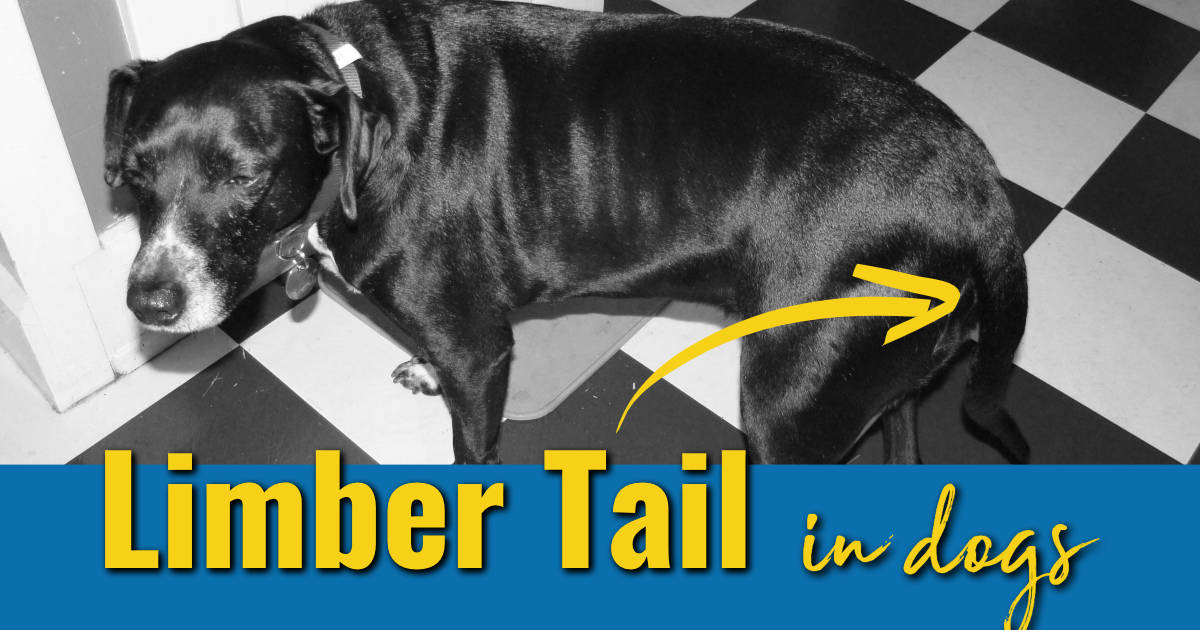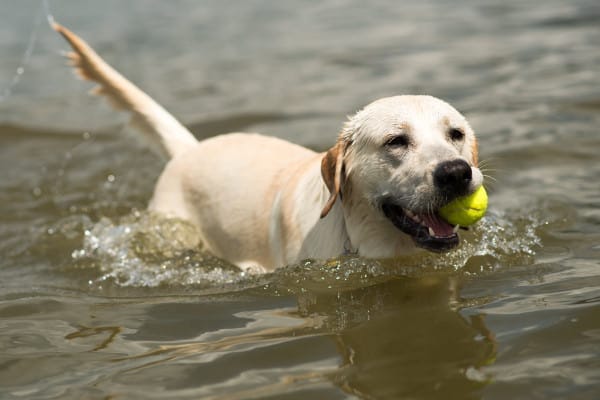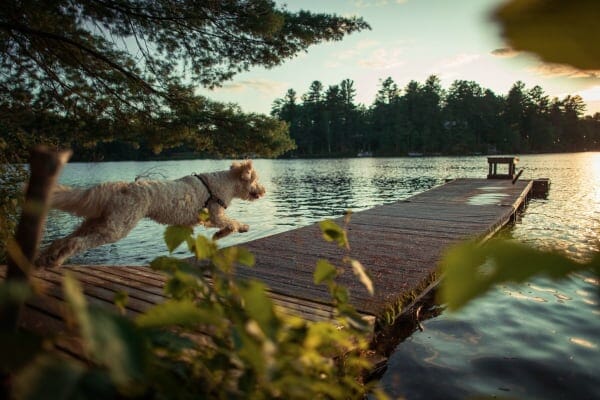Laid-back summer days may mean water sports for your canine companion and you. If your dog’s tail “goes limp” or “looks broken” after swimming (or even after a bath) it could be limber tail syndrome in dogs (i.e. acute caudal myopathy). Practicing veterinarian Dr. Julie Buzby shares one dog’s experience with this painful condition that often has a mysterious water association. By the end of this article, you’ll know the facts, causes, symptoms, and treatment for limber tail.

“I’m taking Banjo to the vet. Call me when you can.”
My sister lives four hundred miles away, so her voicemail one Saturday morning was all it took for me to know something was majorly wrong with her dog. Especially since the day before my sister had followed my seven tips for improving canine lab tests at a routine vet visit, and her dog, Banjo, checked out perfectly. What changed between then and now?
I immediately called her back. My sister explained that she believed Banjo broke his tail after hitting it on her iron bed. Her beloved dog’s tail was suddenly limp and crooked.
Banjo’s diagnosis: Limber tail syndrome
A broken tail? That didn’t sound right to me. As I listened to her, a condition that causes dogs to have a limp tail came to mind. I asked if Banjo had been in the water yesterday.
My sister confirmed my suspicions when she said that she’d given her dog a bath the previous day.
“I think he has something called limber tail syndrome,” I explained. “The bad news is it’s excruciatingly painful. The good news is he’s going to be fine.”
This summer as temperatures rise and your own four-legged friend looks to beat the heat with a dip in the lake, a romp in the waves, or a cold water bath, be on the lookout for a suddenly droopy and limp tail. Like Banjo’s, it very well might be limber tail syndrome. While this condition is not as well-known as other summer-related hazards for dogs such as heat stroke in dogs, canine fireworks anxiety, and blue-green algae toxicity in dogs, it’s one that dog parents should be aware of.

What is limber tail syndrome?
Limber tail syndrome, or acute caudal myopathy, is a relatively common condition in which a dog’s tail either drops down from the base or extends horizontally three or four inches and then continues downward.
It is also known as:
- Broken wag
- Cold tail
- Dead tail
- Frozen tail
- Lab tail
- Rudder tail
- Swimmer’s tail
Limber tail is common in sporting and hunting dogs like Labrador Retrievers, Golden Retrievers, Setters, Pointers, and Foxhounds.
What causes limber tail in dogs?
While the exact cause of a dog’s limp tail isn’t always known, it is thought to be caused by damage to the muscles of the base of the tail. Think of it as the muscles being sprained or strained.
One research study on “cold tail” examined four Pointers with this diagnosis. It confirmed evidence of damage to the muscles of the tail via bloodwork and electromyography.
This muscle damage is usually due to overuse during swimming or bath time.
Why is my dog’s tail suddenly limp?
A dog naturally uses his or her tail for balance. When in the water, the tail aids in steering and changing directions in addition to balance. This can cause a limp tail in dogs due to overexertion.

However, there are other conditions that can also predispose dogs to developing a limber tail. This includes:
- Cold weather and cold temperatures
- Temperature and humidity changes
- Long periods of time spent in a kennel
- Rapid increase in exercise (no training/building up to it)
- Exposure to cold water
If you have ever exercised during wintertime, you know that your muscles are tight and need “warmed up.” This is why it is important to stretch before exercising. Sudden exercise/exposure can increase the risk of muscle injury or strain. It’s the same for our dogs too.
A common misdiagnosis
In my years at veterinary school, never once did I learn about limber tail syndrome. In fact, if it hadn’t been for a seasoned colleague early on in my vet career who set me straight, I would have misdiagnosed my first patient who had the tell-tale signs of limber tail.
Unfortunately, it’s common to misdiagnose limber tail for other conditions such as:
- Trauma to the tail
- A prostate problem
- An anal gland problem
- A fracture in the hind end
- A disc herniation or intervertebral disc disease in dogs
- An infection
And while it’s important to rule out these more serious conditions, limber tail is the most likely diagnosis for water-loving dogs with the classic symptoms.

Symptoms of limber tail syndrome
Limber tail syndrome is a strange phenomenon, and it seems to take dog parents by surprise. Especially if your dog loves the water, it’s important to know the following common symptoms and risk factors of limber tail syndrome:
- Pain at the base of your dog’s tail (where the tail meets the body)
- An inability for your dog to hold the tail normally
- Dog’s tail hanging limp and droopy-looking
- Dog’s tail limp and swollen
- Reluctance to wag or move the tail due to pain
- Dog’s tail limp and won’t wag
- Licking or chewing of the tail
- Recent exposure to water such as an ocean, lake, river, or cold water bath
- Recent strenuous work or exercise, especially for sporting breeds like English Pointers, Labradors, or Beagles
- Prolonged crate confinement from travel or being home alone
Exposure to water is a consistent clue in all the cases that I’ve seen over my 25+ years as a veterinarian. It’s important to note, however, that a limber tail diagnosis does not require recent water activity.
My dog’s tail is limp: Pain or no pain?
As you can see from the list of symptoms above, swimmer’s tail can look differently for different dogs. This is because every case occurs due to a different muscle injury, and no two dogs are the same.
In most cases, if your dog’s tail is limp from limber tail, there is usually pain associated with the injury. This is especially true for dogs who are very active and tend to overuse their tail.
But in some cases, the injury may be very mild — so your dog’s tail might be limp but no pain. Think about it like a rolled ankle. Sometimes you take a weird step and just roll your ankle a little. It’s stiff but you can still walk fairly pain free. Other times, you roll your ankle so bad you injure it to the point that you need a boot or cast. This variation in pain is very similar to what a dog with a limp tail might feel. (By the way, it’s also important to call out that dogs are very stoic and may mask pain.)
Overall, limber tail tends to be painful more often than not.
How is limber tail diagnosed?
Thankfully, limber tail is a fairly easy diagnosis to arrive at. It will involve a visit to your veterinarian, though.
When you and your dog arrive at the animal hospital, your veterinarian will examine your dog. A physical exam will be performed to look for signs of injury, pain, and abnormalities in the tail.
If your dog has the “classic history” of swimming a lot recently, your vet might arrive at the diagnosis of limber tail right away. If not, he or she might need some diagnostics to help rule out other diseases first.
For example, limber tail can present similarly to a dog with a broken tail. In order to diagnose between limber tail vs a broken tail, your veterinarian might take X-rays. The findings from X-rays can help rule out some of the other disease possibilities mentioned above, too.

What is the treatment for limber tail in dogs?
If your dog has been diagnosed with swimmer’s tail, you are probably eager to know what’s next. How do you treat limp tail? Thankfully, dogs with limber tail syndrome typically only take a few days to recover. With a combination of rest, time, and anti-inflammatory medication for pain, most dogs significantly improve within a short period.
In addition to anti-inflammatories, your veterinarian might prescribe a medication called gabapentin. Gabapentin for dogs is becoming more common as a treatment option. The reason I personally like gabapentin for limber tail is because it usually has fewer side effects than anti-inflammatories. Also, gabapentin can help calm down dogs who are energetic and don’t want to relax.
Home treatment for limber tail
Speaking of relaxing, this is the most important part of treating a dog with limber tail. If you want a home treatment option for your dog with a limp tail, rest is the best thing you can provide for your dear dog.
As I mentioned, limber tail usually happens from overuse. So in order for a dog’s limp tail to heal, the tail needs to rest. I know this is easier said than done, though. How do you stop a happy dog from wagging his or her tail? If you have an enthusiastic dog, the answer is, you probably can’t.
However, you can avoid creating excitement to help reduce the amount of wagging. This means no doggy play dates with friends, no guests over to the house if that excites your dog, limiting activity to leash walks only, and less playing at home.
On the other hand, it is important not to restrict your dog too much by putting him or her in a crate for long periods. Lying in a crate, especially if it is small, can make your dog’s tail muscles stiff. This can make your dog’s limp tail even more sore and painful.
Most importantly, you should avoid giving your dog baths or letting him or her swim while healing.
If you are like my sister, you are probably asking, “What can I give my dog for limber tail?” Unfortunately, there are not any over-the-counter medications that are safe for dogs and would help with a limp tail. If you want to give you dog more than just rest, I recommend adding in a hot or cold pack. The ice or heat pack can be used to help reduce swelling and inflammation in the tail.
How long does limber tail last?
Limber tail usually only lasts a few days. That was certainly the case for Banjo. A few days after our Saturday morning conversation, my sister called to share that her dog was once again happily smacking his wagging tail into her legs and furniture.

Interestingly, I have had a few of my patients with this diagnosis receive immediate relief from veterinary spinal manipulation (ie. a dog chiropractic adjustment of the sacrum), but the majority do not.
What is the prognosis for limber tail?
On top of healing quickly, I am happy to say that the prognosis for limber tail is usually good. If you rest your dog and allow time for the tail muscles to heal, the tail should make a full recovery.
If the rest period is not long enough, it is possible that your dog will re-injure his or her tail.
How can you prevent limber tail?
Some dogs, especially those predisposed for limber tail, can develop the condition a second time. I have even had a client whose dog’s tail is limp after swimming every summer.
The best way to avoid this happening to your dog is through conditioning. By exercising your dog and slowly building up to more strenuous activities, you can help your dog strengthen his or her muscles. Think about if you were training for a marathon or to climb a mountain. You can’t just wake up one day and decide to go complete this activity. You spend months training and preparing your body.
The same needs to happen for your canine companion. If your dog spends all year resting and then is suddenly active all day long and every day, his or her tail is more likely to become fatigued and injured. So, it’s important for you to help your dog build up strength by starting with short swims a few times a week. By slowly adding more time in the water, your dog should be better prepared.
And just like before you run, you should always “stretch your dog.” Of course, by this phrase I don’t mean actually stretching your dog’s legs into fancy poses or anything like that. Rather, I mean giving your dog a bit of time to stretch his or her legs. For example, if your dog has been confined in the car or kennel, give him or her a short leash walk. This will help your dog calmly and naturally stretch his or her muscles. Once your dog’s had a chance to stretch, you can let him or her run, play, and swim!
This “warm up” isn’t a guaranteed way to prevent limber tail from happening again. So, if you see your dog’s tail limp after a bath or other activity, you should stop and check your dog. You may even want to give your furry friend a tip-to-tail dog wellness scan.
As always, please speak with your veterinarian if you’re concerned about your dog’s tail or any other body parts!

A simple action plan
This summer, as you venture outdoors, know the risks of limber tail in your water-loving dog. If you do see sudden onset of symptoms, you’ll have a hunch on the diagnosis. And you’ll be ready to set up an appointment with your veterinarian to formulate a plan.
Now, enjoy the warmer days and have a ball watching your canine companion make a huge splash — whether that’s in your bathtub, off the end of a dock, or in the foam of the salty tide.
Has your dog ever had a limp tail after swimming or bathing?
Please comment below. We can all learn from each other.


My Cape Shore Water Dog is going through this right now it’s the second time he has had it. As I suspected he got over it last time and you reaffirmed what I thought he will get over it with rest.
Hi Darrell,
I am sorry your pup is dealing with limber tail for the second time. I am glad the article was able to offer clarity and peace of mind. Wishing your boy a speedy recovery!
I appreciate your thorough article. This morning my 2 year old Golden Retriever woke up with a sad tail. Nothing directly happened to cause it. I can only think that we played too much fetch yesterday. We have been heating it (she really enjoys that) and resting. I think she’s soaking up all the pampering (we don’t mind it either). Glad it’ll be better in a few days. If it’s not- to the vet we go!!
Hi Angela,
Thank you for the positive feedback about the article! I am sorry your Golden experienced this worrisome condition but glad she enjoyed resting and getting tons of attention. Hoping things resolved quickly and all is well today. Best wishes to you both and take care!
The article is very interesting and useful. I live in Mexico and it’s not a very well-known syndrome. My dog started with discomfort eight months ago, biting his tail suddenly, especially when he got excited. First they thought it was an allergy to the change of diet, then their anal glands, then the deterioration in their cartilages by age (8 years) so they took RX. Now he was in kindergarten and he swam a lot in the lake and he arrived very, very badly. He has a hard time defecating so he cries when he does. Initially the veterinarian continued with treatment as if it were a joint but I found this article and we saw that it responded perfectly to his condition. He has been ordered the gabapentin but it has already been 4 days and his improvement has been very slight, how long can it take to improve?
Hi Patricia,
I am sorry your boy is experiencing this painful condition. It can take several days for it to resolve but I would have thought there would be improvement by now. Hoping the gabapentin will be exactly what he needs and that you will see results with a little more time. Wishing your sweet boy healing so he can get back to living his best life!
My pup woke us up this morning by loudly yelping and tucking her tail. I suspect she has limber tail as she finally got to swim yesterday after the pool was too cold over winter. She’s a very active dog and is very sad right now and confused. I had no idea this was a thing!
Hi Sydney,
Yes that does sound suspiciously like limber tail. It has been a few days now, so hopefully she is starting to feel better! If not, don’t hesitate to reach out to your vet for help.
Hello, my 4 yr old Scottish Terrier was boarding at the breeder’s over the weekend. (Out for regular playtime and not confined to kennel or crate). When I picked him up I thought I noticed he was holding his tail down funny, but he does hold it down now and again. I gave him a warm bath that evening and since it was a warm evening I just towel dried him. When we went to bed I noticed he was shivering so I put a warm heating pad against him and the shivering stopped and he slept well all night.
The past 4 days he still continues to hold his tail down in a curved shape. Typically his tail is straight up especially if he sees another dog and he even will hold it almost completely across his back.
He has held it up these past few days when encountering another dog, but not erect, and only for amoment, and certainly not over his back..
I have felt his tail, gently held it up and he shows no indication of pain. He is eating and having bowel movements as normal.
I’m going to see if I can get him into see the vet this morning.
Hi Cynthia,
I am sorry your boy is experiencing these worrisome symptoms. Without examining him myself, it is hard to make specific recommendations. I will say that based on what you describe, this does not sound like limber tail to me. I am concerned there is something else contributing to his odd behavior that needs to be investigated right away. If you have not already had your vet examine your pup, I encourage you to schedule an appointment as soon as possible. Hoping all is well and praying for a positive outcome. Best wishes to you and your sweet boy.
Very helpful article! My three year old heeler typically has a very confident tail position, curled up and quick to wag. Yesterday evening while playing fetch in the yard with his brother, they had a passing collision and I immediately noticed his tail dropped, he was looking around like he didn’t know what happened and for the rest of the evening the tail was down and he was very reluctantly only wagging the tip. I have been watching him this morning and he doesn’t want to sit and hasn’t finished his breakfast. After finding your article, it does sound like he has a sprain or strain. He is not as enthusiastic about swimming as his brother typically but three days ago at the lake he did swim more than he usually does. Perhaps the combination of more water work and the accident playing led to a more serious strain. We’ll let him recover for a few days and monitor. If it isn’t better, I’m thinking a chiro adjustment might help in this case. Thanks again for such a complete explanation of this occurrence.
Hi E,
Thank you for the positive feedback about the article. I am glad you were able to recognize the signs of a tail strain and can monitor your boy for any changes over the next few days. Hoping he will make a full recovery and wishing you all the best!
Thank you for the informative article! We returned from a camping trip today and had to bathe our 8-year-old Belgian Malinois, Zephyr, due to the muddy conditions. Despite his dislike for baths, he endured it. Later, I noticed his unusual behavior, including a squeak and a hanging tail. He seemed uncomfortable and retreated to my office. After reading your article, I wonder if the bath’s water pressure might have caused his discomfort.
Hi Natalie,
I am sorry Zephyr is enduring this painful condition. It does sound like he is experiencing limber tail. I would not blame the water pressure, as this is usually caused by cold temperatures, muscle strain, or overuse. Please reach out to your vet and see if they can prescribe some pain medication as this can cause a great deal of discomfort. Hoping Zephyr will heal quickly and can get back to living his best life very soon. Best wishes and good luck!
Brought our Golden Retriever for a swim and run and it was a bit breezy and were small waves coming to shore. We threw a couple of sticks into the water for him to fetch swimming into the waves. After that we took him for a bit of a run in the bush along a path abs back to swimming for a bit. He seemed fine until that evening when we went to bed. He kept panting excessfully and couldnt get comfortable. The next morning we noticed that his tail was limp and wasn’t his active self. I researched this and it appears that it is a strain/sprain at the base of his tail. We will keep him calm for the next few days and if not any better, we will be bringing him in to see our vet. This is the first time this has happened and he is loves being in the water.
Hi Deborah,
I am sorry your Golden had to experience this painful condition. Hoping it resolved quickly and did not need additional intervention from your vet. Praying all is well and wishing you many happy days ahead.
Awesomely helpful article!!!!!!! THANK YOU……… XOX. 😊
Our girl🐕 looks identical to the dog pictured in the article above “X-rays maybe recommended”…. Her dog friend had been on vacation for 3weeks and yesterday when they got together at the lake for a play date she was exceptionally rambunctious. She’s usually a bit pensive in water activities but NOT yesterday. The water temp was COLD. (Typical Colorado March temps in the 40’s ish…..). Her tail today was vertical 3” out and hung down. Reluctant to wag with her normal enthusiasm . When I tried to touch it she YELPED which in 5 years I’ve never heard her do. Of course it’s a holiday weekend so finding this article has been a HUGE relief. Cannot say thanks enough……….
Hi ElizabethRose,
I am sorry your girl is dealing with this painful condition. Thank you for the positive feedback! I am glad the information was insightful and helped to empower you as you advocate for your girl’s health and well-being. Hoping all is well and she has made a full recovery. Best wishes and give your sweet girl a hug for me! ♥
I just came across this article and I think I will be able to sleep tonight. My husband and I just got home from a vacation and we had been gone 8 days. Our 16 month chocolate lab was home with his auntie but we had two feet of snow while we were gone. My husband plays hard with him everyday so he’s had over a week off so it was probably the cold and the exercise he hasn’t had in a week that did it, or maybe he banged his tail greeting us when we got home late last night. Either way I noticed his tail goes out about three or so inches and then straight down. He still wags it but it just hangs down and he doesn’t seem bothered by it at all unless I try to touch him to see if it’s swollen. He just moves away so we can’t touch his tail at all. Other than that he is acting and eating normally. Still going to the bathroom normally. He just hasn’t asked to go outside much since the play session and has been laying around. Before the playtime he was wanting outside every 15 minutes to run around. I’m calling the vet in the morning but not rushing to ER because I have a feeling it’s just limber tail and not a broken tail!
Hi Heather,
I am glad to know the article was informative and helped to give you some peace of mind. I think it is good you are still planning to reach out to your vet just to remain cautious. Thank you for sharing your experience with us. Hoping with rest and time your boy will be feeling good as new again soon. Best wishes and take care!
My 2 yr old boxer came down with this same thing last winter when we got a lot of fresh snow. We spent a couple of hours playing in the snow (which she absolutely loves!) and that same evening we noticed her tail hanging limply. It took about a week for her to completely recover.
Yesterday we got some fresh snow over a foot deep. I made sure she had a sweater and a coat on before going out and I limited her time out to be no more than 45 mins at a time. We went out 4 times during the day yesterday and this morning she woke up in pain with a limp tail again! I grew up with boxers my entire childhood but back then they docked the tails of boxers ( which is illegal here now) so I had no idea this was a thing. I gave her some gabapentin leftover from spaying and she’s resting comfortably. I feel awful letting this happen again but she is such a high energy dog that needs to get out and run daily. She is in top shape but I wish there was a way to prevent this from happening again but since she’s had it 2 times now I’m sure it will happen again. If anyone has any suggestions I would love to hear them,
Thanks
Hi Michele,
I am sorry your Boxer has experienced this painful condition for a second time. I am not sure of a good way to prevent this but wonder if it would help to give an anti-inflammatory medication before playing in the snow? It could be worth a try. I encourage you to reach out to your vet for advice and guidance. How is your girl feeling today? Hoping all is well and she has made a full recovery. Thank you for sharing your experience with us!
My Beagle/Aussie Shepard mix was rolling around in other animal waste in the woods yesterday AM, gave him a bath outside with the hose water, it was very cold and the air temp was below 50 degrees. Loved the bath rub down, dried him off, saw no issues throughout the day/night or even this morning. However, by mid-morning I notice the tail at the base was humped and down. We went for a walk and he stopped several times to chew at his tail/the base and was uncomfortable. He is now resting thanks to this blog and info. He is eating well and drinking water. Besides rest and time, is there anything else that can help?
Hi Kirk,
I am sorry your pup is dealing with this painful condition. Rest will be the main treatment, but a pain medication and anti-inflammatory would be of great benefit as well. I encourage you to reach out to your vet. They will have some options and can guide you toward the best fit for your pup. Wishing your sweet boy a speedy recovery!
My 1 year old Lab fell in the pool yesterday and the water is fairly cold. She hadn’t ever gone swimming before so suddenly falling in from a high ledge with no exit nearby was very scary for her and me. She seemed fine the rest of the day and I gave her a warm shower after. That night when she went to bed she started moaning and groaning and moving positions over and over all night long. I gave her CBD and she eventually went to bed. Today I noticed her tail looked weird, she was holding it a few inches away from the base and then just hanging down. Looks just like the pictures. I never thought cold water could hurt her tail! Thanks for the informative article, I just feel so awful I didn’t know she was in pain 🙁
Dear Jessica,
I am sorry your Lab experienced this scary situation yesterday. I am glad you were able to figure out what the issue was and now you can get her some help if she is still uncomfortable. Hoping she has been able to make a full recovery and all is well. Wishing you both the best!
I can’t thank you enough for publishing this article. I noticed last Sunday that my Olde English Bulldogge’s tail was swollen at the top and straight out a couple of inches from the base and then straight down (identical to photos I just found under ‘limber tail’ search).. I had my husband rush her to the vet on Monday, thinking possibly she needed her anal glands expressed, and he was told that all was fine and her tail was just fluffier at the top and thinner at the bottom. All week I’ve noticed she’s not been wagging (she’s not the most enthusiastic wagger, but certain situations she will – and wasn’t)….so I just did some internet searching and found this. THANK YOU for confirming something was going on. . A veterinarian once told me many years ago, “you see your dog every day, and will notice tiny things that are unusual – trust your instincts that something is different”.
Hi Danielle,
I am so glad the article was helpful and offered you some peace of mind. Thank you for the positive feedback. You are absolutely right that you know your dog better than anyone! Trust your gut and if you think something is wrong, keep advocating for your dog until she gets the attention she deserves. Thank you for sharing your experience with us. Wishing you the best and keep up the good work!
I have a pug that works as a therapy dog at the local hospital (for the past year). I notice that while visiting and engaged, her tail is curled as normal. But after a while of standing while I visit with a patient, her tail uncurls. This is my 3rd pug but the first to ever let her tail unfold like this. It curls back up once someone re-engages with her though. Someone mentioned limp tail syndrome but based off of this article, it doesn’t seem the case. I just think she gets relaxed and let’s her tail down. Would love to hear your thoughts. She’s 3 years old.
Hi Sindy,
First off, I wanted to say thank you to you and your pup for bringing joy and comfort to those in the hospital. I’m sure everyone there loves your visits!
To answer your question, I suspect you are spot on with your guess that when she gets relaxed, her tail relaxes, and when she is engaged, her tail perks back up. Dogs can communicate a lot with their tails, and it sounds like she is particularly expressive. However, if you ever see any signs of pain or sudden change in tail carriage or use, it never hurts to mention it to your vet.
Thanks again for all the good you and your therapy pup are doing!
late to the party, but just found this article. our black lab, Sadie went to the lake for 2 hours yesterday, and came back with limber tail. our normal vet was already closed, but hubs previously had dogs with this condition. we gave the Sadinator a baby aspirin so she could get comfy enough to sleep. she’s got some movement back today, and I’m sure will be back to chasing squirrels in a few days!
Hi Rebecca,
I am sorry Sadie experienced this painful condition but glad you were able to recognize it and get her comfortable. Just a word of caution about aspirin in dogs. Even though they are called “baby” aspirin, the dose can still be too large for some dogs and cause some very nasty side effects. You may want to talk to your vet and see if they will let you have some extra doses of a pain medication to keep at home in case this happens again. Glad Sadie improved quickly and hoping all is well. Keep up the good work!
Thank you for this article! I am from New England. We just had over a foot of snow and my dogs were out playing for hours, much more than usual since they are both very low energy. Today I noticed Bruin’s (Catahoula/lab mix) tail hanging down and this article saved me a visit to the vet. I even have some Gabapentin leftover from his heartworm treatment so hopefully that will help if he is in pain. Thank you for putting my mind at ease!
Hi Erin,
I am glad the article was helpful and offered some peace of mind. Thank you for the positive feedback! Hoping Bruin will be feeling better soon. Take care and stay warm. ♥
Our two year old pointer gets limp tail every time she gets a bath! She’s not much of a swimmer, and hates bath time. As near as I can tell she must just strain her tail from being so tense in the tub.
Hi Stephanie,
This sounds like what I see frequently in some of my own patients. Glad you know what to look for and can help your girl through these episodes. Thanks for sharing your experience with us!
My dog has hip dysplasia and his tail is always lopsided horizontally (he’s a bernese), I always thought it was because he is trying to balance himself out as it is always to the left where he has less coverage on that hip. He also loves water and loves to swim, so could balance for those who have hip/ortho issues be another reason for a lopsided tail?
Thanks so much in advance!
Hi Lauren,
Yes! Dogs may hold their tails to the side to help with balance. They can also show this same behavior due to arthritis in the tail vertebrae or other conditions that can affect the bones of the spine.
The first time Maggie had limber tail we were quite confused about what had happened. We had company with kids jumping off the dock over and over and of course Maggie couldn’t resist. The next day she was a different dog hanging her tail down and she had trouble sitting down comfortably. Thankfully family with a history with labs could explain to us what had happened. In 2 days she back to her normal self. It was not the last time she had a problem with limber tail but we knew what to expect.
Hi Sonia,
I am glad you had family with experience with this condition who were able to give you some insight. Maggie sounds like a fun-loving pup! Glad she recovered quickly and now you know what to watch for in the future. Thank you for sharing your experience with us. Best wishes!
I found this extremely interesting and educational. We have a sweet girl named Piper. She is a mutt…DNA testing told us 25% each German Shepherd, Staffordshire Terrier, Boxer and 37.5% mixed breed (and yes I realize that’s more than 100%)! Anyway, 2 summers ago while at the beach, she had something similar. We were with a ton of family and a toddler. She suddenly was very protective of her tail and she wouldn’t wag it and was certainly limp. She was able to pick it up enough to poop but it really bothered her. We assumed she’d gotten stepped on. Because she was functioning well otherwise, we didn’t have her seen. It took several days but resolved. However, she’s still occasionally very grouchy if you rub her back hi area or tail base. She’s very active and runs, swims and jumps so I’ve never had her seen about it. Actually I’ve never mentioned it to the vet before! Thanks for the article!
Hi Alison,
I am glad you enjoyed the article and found it informative and helpful. From what you described; it does sound like Piper experienced limber tail that summer. It might be a good idea to mention it to your vet just in case your pup has another episode sometime in the future. Thank you for taking the time to share your experience with us. Oh…aren’t those DNA tests just so interesting?! Best wishes to you and yours.
Would laser therapy be of benefit for limber tail? Seems so.
Hi Leslie,
I have never had the opportunity to try laser therapy on a limber tail patient. But I am in agreement with you! I definitely think laser therapy could be of great benefit for this condition.